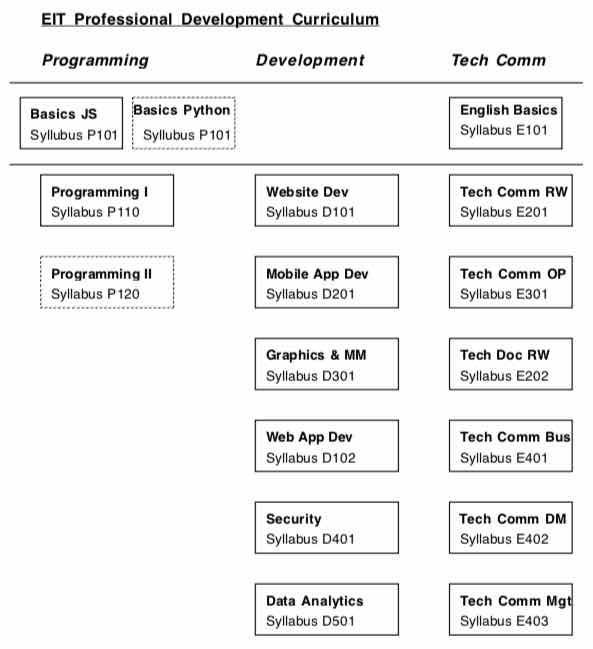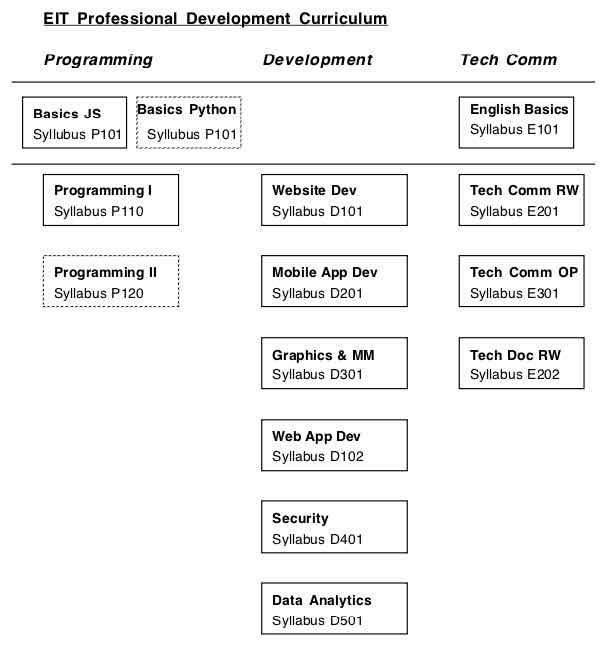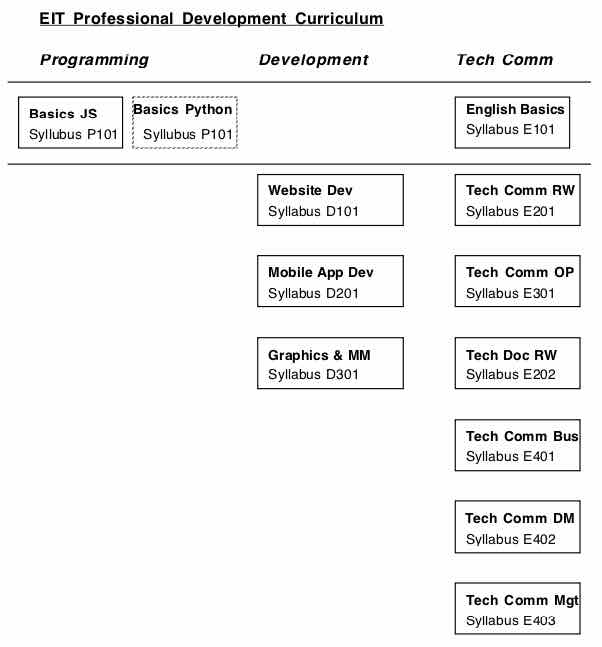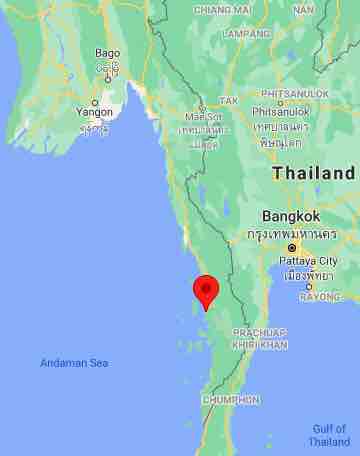About
PDP (Professional Development Program) is one of programs offered by EIT (English & IT, pronounced "eight") for educational opportunities to the youth in developing countries.
Mission
PDP aims at providing the youth in developing countries who are keen to become professionals with skills of English and/or IT with opportunities of hands-on training by experienced professionals and development of their knowledge & skills for their professional careers.
Long-Term Goal
Foster & Help the Youth in Developing Countries Aquire Their Skills toward Careers of IT Professionals or Technical Communication Specialists
Internship / Apprentice
We plan to create internship/apprentice opportunities for our trainees through the digital marketing agency Digital ZeeKwet to work with experienced IT professionals in an actual project for a job order from a client of Digital ZeeKwet.
In the future, we would like to incubate IT startups in remote areas (like Myeik) such that pairs or teams of IT professionals and technical communication specialists work together for job orders from foreign clients.
Short-Term Objectives
- Offer a free "IT Coaching" program to the youth with basic IT literacy who will be trained to develop their "practical skills" for becoming IT professionals through "hands-on" practices
- Offer free lessons of "English Technical Communication" to the trainees for getting ready to international working environments and/or becoming technical communication specialists
Trainees in our program can enroll in (a) or (b) or both.
Methodology
How Do We Plan to Train Trainees?
Trainees are trained like athletes.
Trainers train them like their coaches.
Learning Methods
The methodology of training in PDP employs the following learning methods.
- Project-based Learning
- Immersion (or Submersion)
The second method for an early stage of acquiring skills of programming may sound unusual to many people and may also be contraversial, although it is well-known & often used in teaching a foreign language. We will present some justification of using immersion (or submersion) for acquiring basic programming skills from our perspective below.
Project-Based Learning
Immersion
Remark:
Curriculum
The following diagrams show structures of our curriculum that consists of two tracks: IT-Track for becoming IT developers and Comm-Track for becoming technical communication specialists. Except the programming basics and the English basics that are prerequisites for training on other topics, there is no specific ordering among topics shown in the diagrams.
- Overall
- IT-Track
- Comm-Track
What Topics Are Selected for IT Track?
The following is a list of major topics tentatively selected for IT Track. Note that these are categories of projects that trainees work on, instead of subjects of courses in academic degree programs. For example, Web application development often requires to use an SQL database and hence trainees learn how to use a database through its project.
- Website Development
- Mobile App Development
- Web Application Development
- Data Analytics
PDP first selects Website Development as an entry point for trainees to acquire basic skills necessary for IT professionals because the topic is "relatively" easy & quick to learn and related to the next two topics.
Mobile App Development and Web Application Development are selected aa the next two topics because they are highly demanded now and expected to remain so in this decade. In addition, our coach is well-experienced on these three topics.
The last topic Data Analytics is selected because it is expected to be the most growing topic in IT fields. Although PDP does not have a coach with professional experience on it at this moment, we plan to invite someone for training on data analytics later at least for a short term.
This list of topics is just tentative and hence subject to change. Whenever we find more attractive & feasible topics, we will update the list.
Example Syllabi
As examples, the following are a few essential topics that trainees learn in their early stage of training in PDP.
Programming Basics
This is offered to trainees without prior experience of programming. They acquire basic skills of programming before they start to learn a particular topic of development. Its syllabus is generic and designed independent of a programming language chosen for it. PDP currently has the only one coach who chose JavaScript as a programming language used for this topic at the first time of offering. In the future, we plan to invite a developer who is well-experienced in Python and ask her/him to be a coach on this topic.
Generic Syllabus (Draft v.0.2)
Website Development I
This is likely the first developer's topic for trainees who meet the prerequisite "Programming Basics". Trainees learn development of websites in different ways: Website templates, CMS (Content Management System) such as WordPress, and custom-made websites.
Generic Syllabus (Draft v.0.2)
Mobile App Development
This is to learn development of Apps on both platforms Android and iOS. Details are to be announced.
Technical Communication Reading & Writing I
This is offered to trainees who already have
basic skills of reading & writing
enough for communication by text messaging in English
(e.g., emails, text chats, and posts on forums).
Trainees develop two crucial reading skills
through hands-on practices.
• Quick &
accurate
comprehension of the essence of technical information
• Quick search for useful &
reliable
sources of information
Trainees also improve basic writing skills for the following tasks.
• Communication by messaging
• Write a concise report or a summary
Syllabus (Draft v.0)
This also uses in part course materials for the intensive course given at Hiroshima City University in Japan.
Who Are Involved?
Stakeholders
• Trainees
• Coaches
Are you interested in joining to PDP @ Myeik, Myanmar, as a trainee or a coach?
Contact UsTraining
The overall length of taining in PDP is not prefixed though, a typical length may be about 2 ~ 3 years for trainees who start without prior experience of programming and 1 ~ 2 years for trainees who start with prior programming skills.
Training Class
A class of training on each topic consists of only a few trainees (max 4 trainees per class) so that a coach can give close intereactions to each trainee. Once a trainee finishes training on a topic, the trainee selects the next topic from available topics. PDP plans to make about 3 topics available to trainees.
Training Sessions
Training on each topic is given in 2 sessions per week (1.5 hours per session), although trainees and their coach remain connected even after sessions by communicating & collaborating with each other on a channel of the groupware Slack.
PDP designs the curriculum & syllabi in which trainees are expected to work at home on unfinished tasks and/or assignments of a session for at least several hours till the next session. At the beginning of each session, a coach is expected to help trainees resolve troubles and/or difficulties that they have encountered.
Training on a topic continues till all trainees complete the topic's expected project(s) and hence there is no definite term of training on the topic. An expected length of training on a topic is typically several months though, it varies topic by topic and also depends on the progress of trainees.
Place for Training
The place of training is a workspace of Digital ZeeKwet by courtesy of its founder.
Admission to PDP
- Free training by a coach who is an experienced professional
- Free lease of a laptop to a trainee if the trainee doesn't have it
Provisional Trainees: Trainees who did not have any prior experience of programming and need to complete prerequisites (Programming Basics and English Basics)
IT Developer Trainees: Trainees with basic programming skills who are tarined in development projects with guidance of a coach
Techical Communication Trainees: Trainees who are trained on technical communication skills by an English specialist coach
Scholarship Awardees: Beside the common benefits to trainees, some trainees are possibly offered a scholorship upon the availability of funds.
People Involed in PDP
Trainees
- The 1st generation of 3 trainees who have no prior experience of programming
- One trainee who is a final-year student of Computer University, Myeik
Coaches
-
Currently only two Burmese coaches
- One professional developer
- One English specialist
Administrative Staff
- Manager
- Founder

































